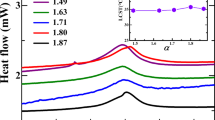Abstract
The formation of colloidal unimolecular polymer (CUP) particles from single polymer strands was investigated as a function of molecular weight. The CUP particle size was correlated with the absolute molecular weight and its distribution. The characteristics of the particles were evaluated with respect to viscosity, acid number, size distribution, and stability. The particle size varied from less than 3 nm to above 8 nm representing polymers with molecular weight in the range of 3000–153,000. Lower molecular weight polymers were found to be unstable. Particle size measurements using dynamic light scattering technique indicated a normal distribution which corresponded to the molecular weight distribution of the copolymer. The statistical distribution of the acid groups in the polymer chains played a significant role in the stability of low molecular weight polymers.














Similar content being viewed by others
References
Kabanov, AV, Batrakova, EV, Melik-Nubarov, NS, Fedoseev, NA, Dorodnich, TY, Alakhov, VY, Chekhonin, VP, Nazarova, IR, Kabanov, VA, “A New Class of Drug Carriers: Micelles of Poly(ethylene)–Poly(propylene) Block Copolymers as Microcontainers for Targeting Drugs from Blood to Brain.” J. Control. Release, 22 141–157 (1992)
Kataoka, K, Kwon, G, Yokoyama, M, Okano, T, Sakurai, Y, “Block Copolymer Micelles as Vehicles for Drug Delivery.” J. Control. Release, 24 119–132 (1993)
Guo, J, Farrell, S, Uhrich, KE, “Interactions Between Unimolecular Micelles and Liposomes.” Mater. Res. Soc. Symp. Proc., 550 89–94 (1999)
Liu, H, Jiang, A, Guo, J, Uhrich, KE, “Unimolecular Micelles: Synthesis and Characterization of Amphiphilic Polymer Systems.” J. Polym. Sci. A: Polym. Chem., 37 703–711 (1999)
Guo, J, Farrell, S, Uhrich, KE, “Drug Release Characteristics of Unimolecular Polymeric Micelles.” J. Control. Release, 68 167–174 (2000)
Morishima, Y, Nomura, S, Ikeda, T, Seki, M, Kamachi, M, “Characterization of Unimolecular Micelles of Random Copolymers of Sodium 2-acrylamido-2-methylpropane sulfonate and Methacrylamides Bearing Bulky Hydrophobic Substituents.” Macromolecules, 28 2874–2881 (1995)
Noda, T, Hashidzume, A, Morishima, Y, “Micelle Formation of Random Copolymers of Sodium-2-acrylamido-2-methylpropanesulfonate and a Nonionic Surfactant Macromonomer in Water as Studied by Fluorescence and Dynamic Light Scattering.” Macromolecules, 33 3694–3704 (2000)
Sato, Y, Hashidzume, A, Morishima, Y, “Self-association in Water of Copolymers of Acrylic Acid and N-Dodecylmethacrylamide, as Studied by Fluorescence, Dynamic Light Scattering and Rheological Techniques.” Macromolecules, 34 6121–6130 (2001)
Kan, CS, “Role of Particle Size on Latex Deformation During Film Formation.” J. Coat. Technol., 71 89–97 (1999)
Riddles, CJ, Zhoa, W, Hu, H-J, Van De Mark, MR, “Colloid Unimolecular Polymers (CUPs) Synthesized by Random Copolymerization of MMA/MAA.” Polym. Preprints, 52 232–233 (2011)
Chen, M, Van De Mark, MR, “Rheology Studies on Colloidal Unimolecular Polymer (CUP) Particles in Absence and Presence of NaCl.” Polym. Preprints, 52 336–337 (2011)
Vidulich, GA, Evans, DF, Kay, RL, “The Dielectric Constant of Water and Heavy Water Between 0 and 40°C.” J. Phys. Chem., 71 (3) 656–662 (1967)
Simha, R, Branson, H, “Theory of Chain Copolymerization Reactions.” J. Chem. Phys., 12 253–267 (1944)
Stockmayer, WH, “Distribution of Chain Lengths and Compositions in Copolymers.” J. Chem. Phys., 13 199–207 (1945)
Amaral, MD, Roos, A, Asua, JM, Creton, C, “Assessing the Effect of Latex Particle Size and Distribution on the Rheological and Adhesive Properties of Model Waterborne Acrylic Pressure-Sensitive Adhesives Films.” J. Colloid Interface Sci., 281 325–338 (2005)
Wicks, ZW, Jr, Jones, FN, Pappas, SP, Wicks, DA, Organic Coatings Science and Technology. Wiley-Interscience, New York, 2007
Hiemenz, PC, Rajagopalan, R, Principles of Colloid and Surface Chemistry. Marcel Dekker, New York, 1997
Ruiz-Reina, E, Carrique, F, “Electroviscous Effects of Concentrated Colloidal Suspensions in Salt-free Suspension.” J. Phys. Chem. C, 111 141–148 (2007)
Ogawa, A, Yamada, H, Matsuda, S, Okajima, K, Doi, M, “Viscosity Equation for Concentrated Suspensions of Charged Colloidal Particles.” J. Rheol., 41 769–785 (1997)
Hernandez, FJR, Carrique, F, Ruiz-Reina, E, “The Primary Electroviscous Effect in Colloidal Suspensions.” Adv. Colloid Interface Sci., 107 51–60 (2004)
Hales, TC, “A Proof of the Kepler Conjecture.” Ann. Math., 162 1065–1185 (2005)
Pishvaei, M, Gaillat, C, McKenna, TF, Cassagnau, P, “Rheological Behavior of Polystyrene Latex Near the Maximum Packing Fraction of Particles.” Polymer, 46 1235–1244 (2005)
Brinkman, E, Loos, F, “New Developments in Water-borne Resins for Industrial Coatings.” Surf. Coat. Int., 3 143–145 (1988)
Wilson, AD, Nicholson, JW, Prosser, HJ, Waterborne Coatings—Surface Coatings, Vol. 3. Elsevier, New York, 1990
Owen, SC, Chan, DPY, Shoichet, MS, "Polymeric Micelle Stability.” Nano Today, 7 53–65 (2012)
Acknowledgments
The authors would like to acknowledge the Coatings Institute and the Department of Chemistry of Missouri S&T for the financial support and resources and to thank Jigar Mistry for help in GPC.
Author information
Authors and Affiliations
Corresponding author
Additional information
This paper was awarded the Shelby F. Thames Best Paper Award at the 40th Annual International Waterborne, High-Solids, and Powder Coatings Symposium, held February 4–8, 2013, in New Orleans, LA.
Rights and permissions
About this article
Cite this article
Van De Mark, M.R., Natu, A.M., Gade, S.V. et al. Molecular weight (M n) and functionality effects on CUP formation and stability. J Coat Technol Res 11, 111–122 (2014). https://doi.org/10.1007/s11998-013-9526-y
Published:
Issue Date:
DOI: https://doi.org/10.1007/s11998-013-9526-y




